18 Ottobre 2012
English
Regular walls – between oblivion and resuscitation*
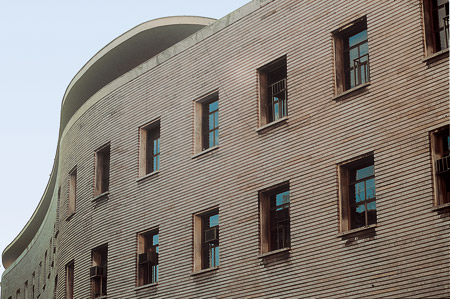
Post office building (1933-36) in Bologna square in Rome designed by Mario Ridolfi (photo: A. Acocella)
We would like to begin this final section of the chapter on stone walls with a lengthy quote from Giorgio Grassi, an architect whose ideas and teachings have been of considerable importance to us; his intransigence and obstinacy in trying to sustain a difficult stand – which at times has appeared to us to be rather isolated, old-fashioned, devoid of any real future in an age when there seems to be little interest in either the past or the future – is something that in the end we instinctively felt to be authentic and of practical value within the framework of our own speculative “laboratory” of ideas.
When we look at architecture from the past, we architects (I think without exception) attempt to reveal its innermost secrets. When I say “architecture” I am talking, of course, about good architecture, about those constructions that come to mind and help us to continue having faith in our work: I am also talking of that secret of theirs which always, however, presupposes its own disclosure (…).
We are interested in their so-called technical secret, that is, their criteria, their methods, their very essence, first and foremost. This is what our observation consists in: we observe in order to learn how things are done; and the first thing we learn, often at out own expense, is that this secret does not belong to the style itself. On the contrary, the style itself, the isolated style, is always an enigma, and as such it discourages us. On the other hand, the positive character of good architecture is something that is part of the style, but also something that exists before and after the style, that precedes the style but also stands out from the style (…).
By sticking to the emergent technical-practical aspect of style, we gradually close the gap that separates it from us. Despite being aware of the importance of the historical, cultural and social factors in the definition of architectural styles, we are more attracted towards the material, practical conditions, towards their operation, which brings us closer to such conditions. When, as architects, we talk of the ahistorical nature of architectural styles, this is what we are really talking about; we see appropriation as the perceiving and sharing of the practical reasons for adopting such styles.
This specifically technical approach to style is also the only way of keeping style at a safe distance. We learn to admire it, to recognise the precision of architectural constructs, the linearity of movement, and we gradually acquire familiarity with the various aspects of a given work; it is the construction, not the style, that moves us.
Our ability to perceive is safe here, there is no need for caution – we observe architecture with the eyes of the apprentice, intent on its practical features, that is, on how it has been designed and built.
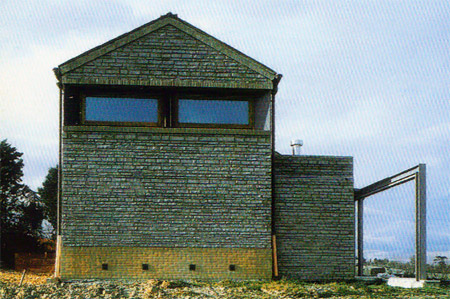
House in Senigallia (1998-2004) designed by Danilo Guerri (photo: A. Acocella)
Any understanding of the “essence” of walled architecture inevitably requires a consideration of considerable historical experience, of technical building methods and rules, in other words, of something that is both insuppressible and long-lasting: this, in turn, brings us to the question of how materials are assembled and joined, compared with the more general figurative character of walls. We apologise to the reader for the fact that we are beginning once again almost from the very start, and taking into consideration things that we apparently already know; however, an investigation of what we tend to consider to be acquired knowledge will give us the chance to see things from a different point of view. We are going to start this final section with an analysis of the concept of “regularity”.
The basic characteristic of regular walls is the use of stones that have been accurately cut and dressed (ashlars, blocks and listels, as well as quoins and sections of cylinders, cones and spheres) so as to give clearly-defined walls (in terms of their vertical elevation). This characteristic is based on the transformation of the material from the world of “shapeless” objects to be found in nature into that of the geometrical order of architecture – whereby stone is subjected to a series of specific measures, ratios and rhythms.
Sverre Fehn reminds us that squared stone represented Man’s first step towards the true modification of the natural environment.
The precise modelling of this stone, generally accompanied by the accurate dressing of its faces, takes precedence over the contingent, heterogenic nature of those stone materials to be found in nature and used in the construction of irregular masonry walls. The building of regular masonry walls generally involves the superimposition of the material in “courses” or “rows” composed of parallelepiped stone ashlars and characterised by the staggering of the vertical joints between adjacent stones. The architectural objective is to create an overall wall design of a basically stratigraphic nature.
This orderly, geometrical arrangement of stones is further characterised by the coplanar facing of the wall, the parallelism of the courses, the equivalence – or comparability – of the individual constituent elements in both morphological and dimensional terms. Traditional and modern methods of working the stone involves a series of procedures and instruments suitable to the creation of the basic elements needed for stone construction, which to this day are known by the name of “ashlars”.
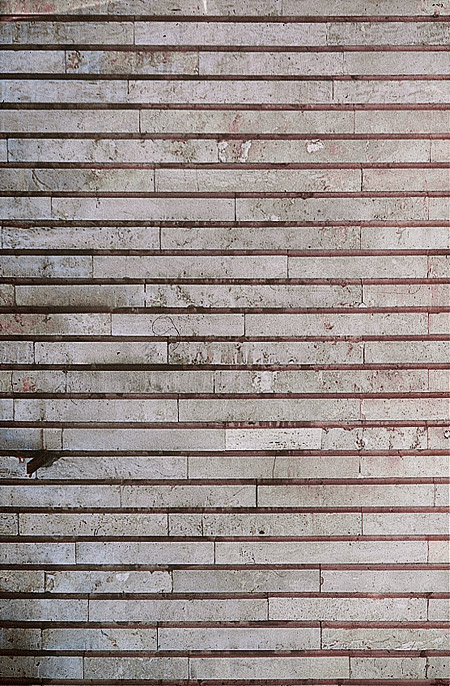
Façade detail of the Post office building in Rome designed by Mario Ridolfi (photo: A. Acocella)
These elements may take various forms, and in the past these forms were the subject of stereotomy (soon to become an important branch of descriptive geometry): today, they are provided by highly advanced numerically-controlled cutting machines.
Walls built from large square ashlars were a feature of stone architecture from the very earliest times right up to the early years of the 20th century, and such works are still as impressive as ever, in terms of both their aesthetic value and their excellent state of conservation.
Recent tradition (in particular that of the second half of the 20th century) has seen a decline in the popularity of stone walls among architects, which have almost always been used in exceptional circumstances: they have made but sporadic appearances in construction programmes (at least in Italy and the more advanced nations) dominated by artificial materials, as a result of which quarrymen, stone producers, the knowledge and constructive skills centred around the working of stone, and the remaining architects to keep alive regular stone walls within their creations, have all been “marginalised”.
We are of course sorry to see familiar objects of study – objects that are part and parcel of our common cultural baggage as architects and citizens – largely disappear from contemporary architecture, together with the knowledge that we cannot do without the stone constructs that surround many of us in our everyday lives (given that many people continue to live – or try to live – in historical towns and cities made of stone or brick, within thick walls whose figurative value and environmental worth we readily recognise, and which cannot be found elsewhere (and which is particularly absent from the architecture of urban expansion).
This decline, however, does not mean that stone has been completely forgotten in recent years; it has always remained a material of prime importance, one that offers unique qualities, albeit within the context of an architecture that has tended to reduce the mass and the strength of the thick stone walls of the past.
Today, the masonry wall represents a traditional architectural vision that has been largely rejected over the past fifty years or so in favour of more modern architectural concepts: this process hardly represents a natural decline deriving from the exhaustion of the material’s inherent potential; on the contrary, it has been more a case of the sudden, intentional abandonment of stone as a major building material. It is as if it were seen as extraneous to modern architecture; that is, a material which, together with brick, has ceased to play its part. However, we are fortunately witnessing numerous architects tiring of the strongly innovative artificial materials, which in modern times have all but replaced stone, and rethinking the role that stone can play in their creations. Their efforts are clearly centred around the making of individual contributions, but taken together, these individual contributions may well auger the beginning of a new season for – or at least the continued survival of – masonry walls within contemporary architecture.
In distancing ourselves from the standardised architecture of today, we have found it intriguing retracing and linking once again contemporary experiences of masonry wall construction; in particular, we found it interesting “sampling” and studying the ways by which present-day architecture has interpreted this long-forgotten building method.
We have set ourselves the task of in some way reunifying such experiences, and linking them with past architectural traditions. The architectural horizon is a vast one, full of styles, models, spatial and compositional themes. The opportunity to compare past and present experience seemed to be a healthy one compared with the more common praxis of contemporary architecture, where individualism and the search for innovation for the sake of it has often led to the undecipherable character – or at the very best to the solitude – of even the most successful of architectural works.
If we now go back to the rules, that is, to the tried-and-tested standards and conventions that have characterised diverse geographical areas throughout history, this does not mean renouncing the updating and modernisation of the language of stone architecture.
Tradition constitutes an intelligible horizon of understanding which undoubtedly “informs” us, to a certain degree, of what masonry walls were like, and “suggests” what they could be like in the future. The comparison with the past thus helps us understand how present architectural projects can in fact attain the qualitative heights of the past, rather than constituting the pursuit of a nostalgic return to traditional models and methods.
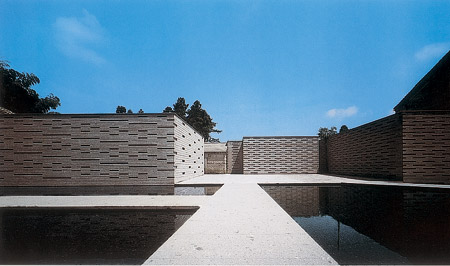
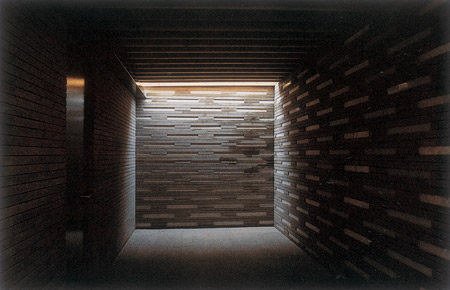
Stone Museum (1996-2000) in Tochigi by Kengo Kuma
Tradition, as Giorgio Grassi tells us, should be seen as the working basis for the development of the architect’s projects in accordance with present-day problems, expectations and sensitivity. The idea of rethinking the wall as an architectural element should not prevent ancient tradition and experience from being evaluated for what it is. Centuries of tradition have taught us the importance of materials and the basic architectural concepts of solidity, stability and longevity: these practical teachings, in fact, are more important that the formal or stylistic features of historical architecture.
Stone can be employed in a vast range of architectural projects, and can give perhaps unexpected results within a contemporary framework. The purpose of returning to its origins is to retrace the timeless features of architecture: that is, its fundamental elements, archetypes and compositional designs. In this present section, therefore, we would like to return to the essential value of walled constructions, of space and of the primary volumes that make up architectural compositions.
In other words, we wish to portray an architecture that goes back to satisfying essential requisites, one that provides satisfactory solutions (the same ones as ever) in the form of constructions designed and built to last for several generations. It is frustrating to see just how little importance is afforded today to well-built constructions made from simple materials (that is, to building know-how and state-of-the-art structures).
While we are fully aware that the traditional masonry wall cannot be re-proposed as a generalised “redeeming” technique, we do believe that it should be taken into consideration on certain occasions, in specific local contexts, where stone can make a significant contribution to contemporary architecture.
Note
* The re-edited essay has been taken out from the volume by Alfonso Acocella, Stone architecture. Ancient and modern constructive skills, Milano, Skira-Lucense, 2006.
